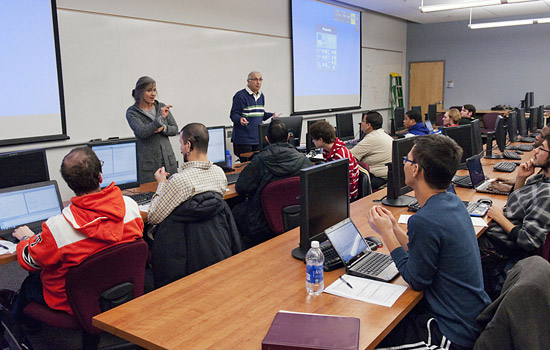Website offers resources to teachers at RIT
Answers questions to make classrooms more accessible for deaf students
Mark Benjamin
Teach2Connect is a new website that provides valuable information for RIT teachers who have deaf or hard-of-hearing students in their classes.
Teach2Connect, a website designed to provide valuable resources for RIT faculty members with deaf or hard-of-hearing students, is now live.
The site is intended for use by both veteran and new faculty. It contains information intended to provide instructors with classroom teaching strategies that foster collaborative learning among deaf, hard-of-hearing and hearing students. It also provides valuable resources to assist faculty in finding answers to questions they might have when working with deaf and hard-of-hearing students in and outside of the classroom.
There are nearly 1,400 deaf and hard-of-hearing students on the RIT campus who are supported by RIT’s National Technical Institute for the Deaf. Of those, 588 are cross-registered in other colleges at RIT and attend classes with predominately hearing peers.
About 25 percent of all non-NTID college classes on the RIT campus have at least one deaf or hard-of-hearing student and some access service provided. Depending on the students’ needs and requests, sign language interpreters, classroom captionists or notetakers – or a combination of them – may be used in those classrooms.
“As these numbers of students increase, it is our hope that teach2connect becomes an integral part of every faculty’s approach to developing their materials and lectures for the diverse student population here at RIT,” says Ann Hager, an associate professor in the Business Studies department of NTID and project leader for Teach2Connect.
Through short video vignettes, RIT faculty share some of the teaching challenges they have faced and strategies they have used to successfully overcome these challenges while working with deaf and hard-of-hearing students. Students also made videos for the website and offer their unique perspective on the challenges they face in the classroom and offer suggestions on how instructors can improve existing teaching practices that can allow greater access to instruction for all students.
“When I first came to RIT, I had some deaf students in some of my courses,” says Carol Marchetti, an associate professor of statistics in RIT’s College of Science. “I was a little nervous, not sure how teaching would work.”
She said an interpreter in her class gave her tips and encouragement to help. For example, many deaf and hard-of-hearing students get information from facial expressions and may read lips to help understand what is being said in the classroom. They may want to sit in the first row, and find it helpful when the teacher doesn’t speak while facing the chalkboard.
“This website is a significant step forward in the process of complete integration of deaf and hard-of-hearing students at RIT,” says Stephen Aldersley, NTID’s associate vice president for Academic Affairs. “Using the experience of students and faculty from all nine colleges of the university, it offers a rich array of suggestions, best practices and proven approaches to ensure student success. It will be useful for all faculty, but especially for new faculty who may never have had deaf students in their classes.”
Since the website went live last fall, presentations are being made about the resource to college departments throughout RIT, NTID and the Provost’s Deaf Access Committee. “We want to make sure that everyone knows there is an easy to access website that can quickly answer questions and alleviate some of the concerns that faculty face while working with deaf and hard-of-hearing students,” Hager says. “This site can be useful to all faculty and staff at RIT and we are more than happy to demonstrate how to access and navigate it to any group at RIT.”
The site also features links illustrating basic signs that would be used in a classroom, and where RIT faculty members can turn to get videos captioned before being shown in the classroom.
Diane Heyden, an engineering studies support coordinator at NTID, worked on the website and is accompanying Hager while telling faculty about the resource.
“We realized that faculty shared many of the same questions related to working with deaf and hard-of-hearing students but did not know who to turn to for the answers,” Heyden says. “This site was designed to provide those answers and more.”














